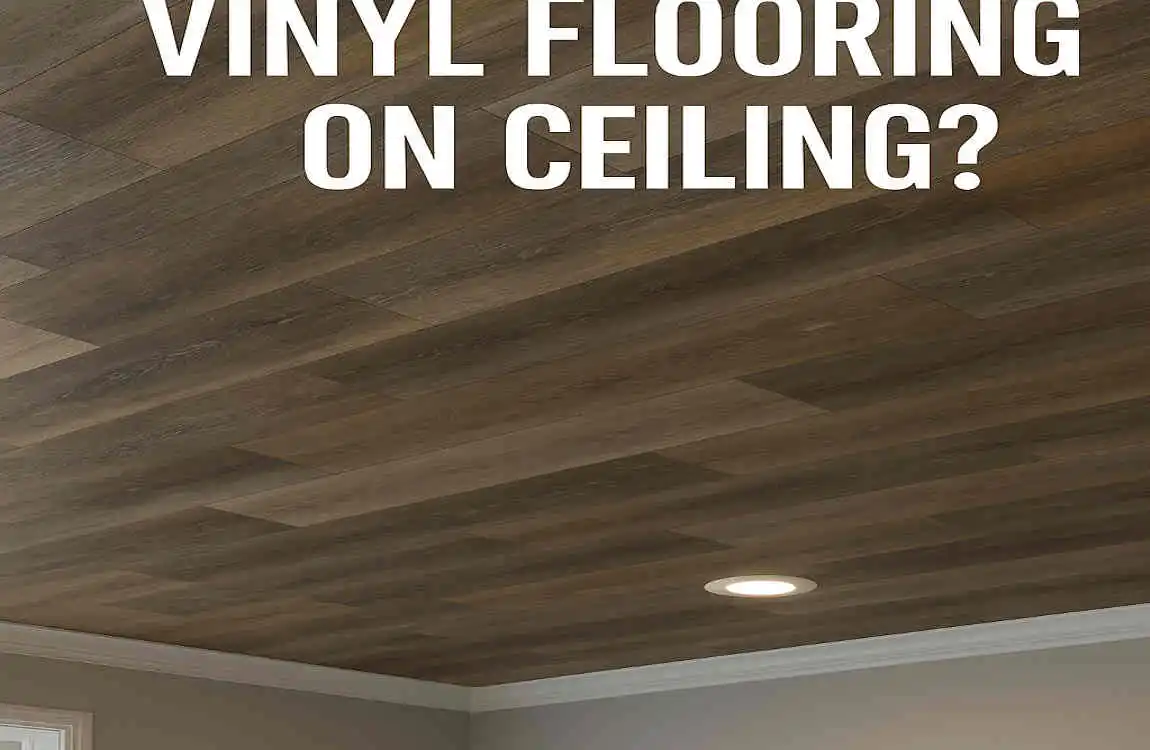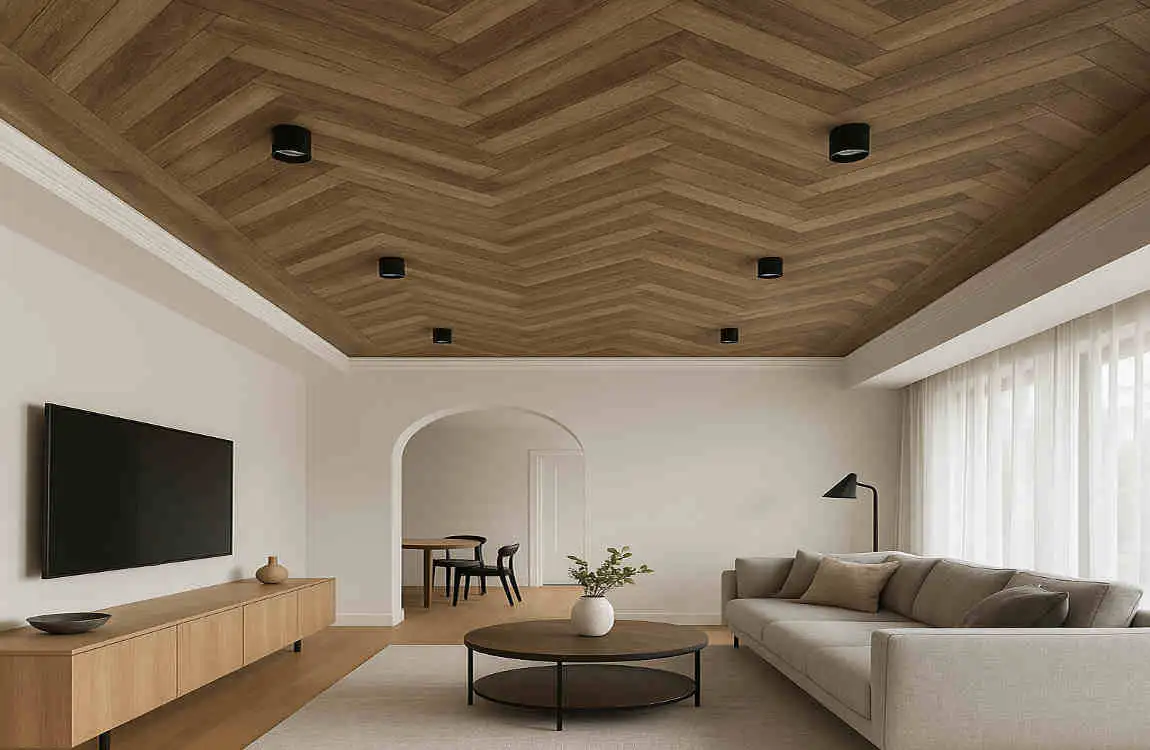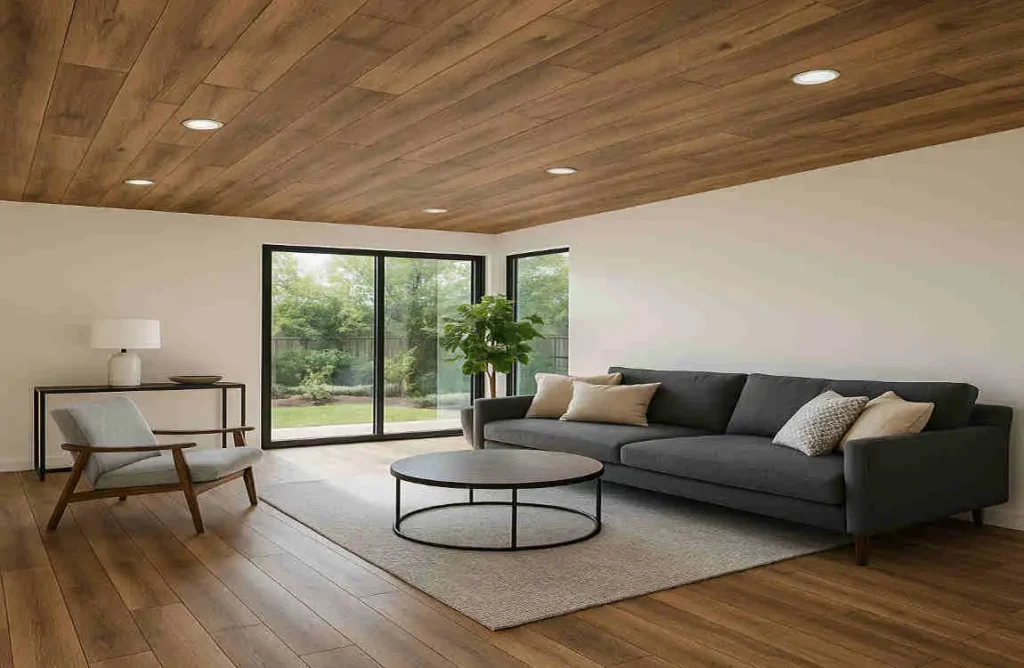Vinyl flooring can creatively be used on ceilings to add a unique, modern design element to a home. Using lightweight, rigid vinyl planks or tiles on ceilings offers durability and an eye-catching aesthetic that brings warmth and texture to a space. This trend is gaining popularity in contemporary homes to create a bold statement and mix textures, combining vinyl ceiling treatments with other design features for a fresh, stylish look.
Understanding Vinyl Flooring as a Ceiling Material

What is Vinyl Flooring?
Vinyl flooring is a synthetic flooring material made from PVC (polyvinyl chloride) and other additives. It’s known for its durability, affordability, and versatility. Vinyl flooring comes in various forms — sheets, tiles, and planks — and can mimic the look of materials like wood, stone, or even concrete.
Typical vs. Creative Uses of Vinyl Flooring
Traditionally, vinyl flooring has been used on floors, but its versatility has led to more creative applications. From walls to countertops to ceilings, vinyl flooring is proving to be a game-changer in home design. But what makes it suitable for ceilings?
Vinyl Flooring’s Properties for Ceiling Installation
Vinyl flooring has several properties that make it an intriguing choice for ceilings. It’s lightweight, which makes installation easier. It’s also moisture-resistant, which is a plus in areas prone to humidity. Plus, its wide range of designs and textures means you can create a truly unique look. However, there are some challenges to consider, like installation complexity and compatibility with existing ceiling structures.
Pros of Using Vinyl Flooring on Ceilings
Durability and Moisture Resistance
One of the most significant advantages of using vinyl flooring on ceilings is its durability. It can withstand daily wear and tear, making it a long-lasting choice. Plus, its moisture resistance makes it suitable for areas like bathrooms and kitchens where humidity levels can be high.
Wide Range of Design Options
From wood-look planks to stone-look tiles, vinyl flooring offers a vast array of design options. You can create a rustic cabin feel with wood-grain vinyl or go for a sleek, modern look with metallic finishes. The possibilities are endless!
Cost-Effectiveness
Compared to traditional ceiling materials like drywall or wood, vinyl flooring is often more affordable. This makes it an attractive option for those looking to add a touch of creativity to their ceilings without breaking the bank.
Easy Maintenance and Cleaning
Another perk of vinyl flooring on ceilings is its easy maintenance. It’s stain-resistant and can be easily cleaned with a damp cloth or mop. This means less time spent on upkeep and more time enjoying your unique ceiling design.
Soundproofing and Insulation Potential
Vinyl flooring can also help with soundproofing and insulation. Its layers can absorb sound, making your space quieter. Plus, some vinyl flooring options have insulating properties, which can help regulate temperature.
Lightweight and Easy to install
Compared to other ceiling materials, vinyl flooring is relatively lightweight. This makes it easier to handle and install, especially if you’re considering a DIY project. However, for more complex installations, it’s best to consult with a professional.
Visual Appeal and Unique Aesthetics
Last but not least, vinyl flooring on ceilings can add a wow factor to any room. It’s a conversation starter and a way to express your personal style. Whether you choose a bold pattern or a subtle texture, your ceiling will become a focal point in your home’s design.
Challenges and Cons to Consider
Installation Complexity
While vinyl flooring is generally easier to install than other materials, putting it on a ceiling can be more challenging. You’ll need to ensure the ceiling can support the weight of the vinyl and that it’s properly secured. This may require additional tools and expertise.
Potential for Damage or Warping
If vinyl flooring is not installed correctly, it can be prone to damage or warping. This is especially true in areas with high humidity or temperature fluctuations. Proper installation and maintenance are key to preventing these issues.
Compatibility with Existing Ceiling Structures
Before installing vinyl flooring on your ceiling, you’ll need to consider the existing structure. Some ceilings may not be suitable for vinyl flooring, especially if they have uneven surfaces or are made of materials that don’t bond well with adhesives.
Professional Installation vs. DIY Feasibility
While some homeowners may feel confident tackling a vinyl flooring ceiling project themselves, others may prefer to hire a professional. Professional installation can ensure a seamless finish and minimize the risk of damage or issues down the line.
Maintenance Specifics for Ceilings vs. Floors
While vinyl flooring is generally easy to maintain, there are some differences when it comes to ceilings. You’ll need to consider how to clean and maintain the vinyl without damaging the ceiling or the flooring itself. Regular dusting and occasional spot cleaning may be necessary.
Creative Design Ideas Using Vinyl Flooring on Ceilings
Wood-Look Vinyl Planks for a Rustic Feel
If you love the look of wood but want something more durable and affordable, wood-look vinyl planks are a great choice. Install them on your ceiling to create a cozy cabin vibe or rustic charm, perfect for a bedroom or living room.
Patterned Vinyl Tiles for Artistic Murals
Get creative with patterned vinyl tiles to create an artistic mural on your ceiling. From geometric designs to floral patterns, the possibilities are endless. This is a great way to add a pop of color and personality to any room.
Metallic or Textured Vinyl for Modern Aesthetics
For a sleek, modern look, consider using metallic or textured vinyl flooring on your ceiling. This can create a striking visual effect that’s perfect for a contemporary kitchen or bathroom.
Vinyl Ceiling Borders or Accent Panels
Use vinyl flooring to create ceiling borders or accent panels that draw the eye upward. This is a great way to add visual interest and define different areas of a room, especially in open-plan spaces.
Combining Vinyl with Lighting Features
Take your vinyl flooring ceiling to the next level by incorporating lighting features. From recessed lighting to pendant lamps, you can create a stunning ambiance that enhances the overall design.
Vinyl Flooring in Open-Plan and Loft-Style Homes
Vinyl flooring on ceilings is particularly well-suited to open-plan and loft-style homes. It can help define different areas of the space while adding a touch of creativity and personality.
Current Trends in Vinyl Flooring Ceiling Designs

Examples from Modern House Projects
Vinyl flooring on ceilings is making waves in modern home design. From sleek, minimalist spaces to cozy, rustic retreats, you can find examples of this trend in action. Take inspiration from recent projects and interior design shows to see how others are using vinyl flooring to transform their ceilings.
Popular Color Schemes and Finishes
When it comes to vinyl flooring on ceilings, specific color schemes and finishes are gaining popularity. From warm wood tones to superb metallic finishes, you can find a look that suits your style. Keep an eye out for trending colors and finishes to stay ahead of the curve.
Trendy Patterns for 2025-2026
In the world of vinyl flooring ceiling designs, specific patterns are set to be big in 2025-2026. From bold geometrics to subtle textures, these patterns can add a touch of personality and flair to your ceiling. Keep an eye out for these trending patterns to stay on top of the latest design trends.
Eco-Friendly and Sustainable Options
As sustainability becomes increasingly important in home design, eco-friendly and sustainable vinyl flooring options are gaining popularity. Look for vinyl flooring made from recycled materials or with low VOCs (volatile organic compounds) to reduce your environmental impact.
Integration with Smart Home and Lighting Technologies
Vinyl flooring on ceilings can also be integrated with smart home and lighting technologies. From color-changing LEDs to voice-controlled lighting, you can create a truly futuristic and customizable ceiling design. Keep an eye out for these cutting-edge technologies to take your vinyl flooring ceiling to the next level.
How to install Vinyl Flooring on Your Ceiling: Step-by-Step Guide
Preparation: Measuring and Surface Checks
Before you start installing vinyl flooring on your ceiling, you’ll need to do some prep work. Measure the ceiling to determine how much vinyl flooring you’ll need, and check the surface for any imperfections or damage that may require repair.
Choosing the Right Type of Vinyl Flooring
Not all vinyl flooring is created equal, so it’s essential to choose the right type for your ceiling. Look for vinyl flooring specifically designed for vertical applications with the desired design and texture.
Installation Methods: Adhesives, Nails, or Interlocking Planks
There are several ways to install vinyl flooring on a ceiling, including using adhesives, nails, or interlocking planks. The method you choose will depend on the type of vinyl flooring you’re using and the existing ceiling structure.
Safety Tips and Precautions
Installing vinyl flooring on a ceiling can be tricky, so it’s essential to take safety precautions. Use a sturdy ladder or scaffolding, and have someone assist you if possible. Wear protective gear, such as gloves and eye protection, and take breaks as needed to avoid fatigue.
Finishing Touches and Maintenance Tips
Once your vinyl flooring ceiling is installed, you’ll need to add some finishing touches. This may include trimming excess vinyl, filling gaps, and ensuring a seamless finish. Follow the manufacturer’s instructions for cleaning and maintenance to keep your vinyl flooring ceiling looking its best.
Cost Analysis and Budget Considerations
Typical Cost Ranges for Vinyl Flooring Materials
The cost of vinyl flooring materials can vary depending on the type, design, and quality. On average, you can expect to pay between $1 and $5 per square foot for vinyl ceiling tiles.
Installation Cost Comparison: DIY vs. Professional
If you’re considering a DIY installation, you’ll need to factor in the cost of tools and materials. On average, DIY installation can cost between $0.50 and $1.50 per square foot. Hiring a professional, on the other hand, can cost between $2 and $5 per square foot, depending on the job’s complexity.
Longevity and Value for Money Insights
Vinyl flooring on ceilings can last for many years with proper installation and maintenance. This makes it a cost-effective option in the long run, especially when compared to traditional ceiling materials that may need to be replaced more frequently.
Potential Savings Compared to Traditional Ceiling Renovation Options
Compared to traditional ceiling renovation options like drywall or wood, vinyl flooring can save you money. Not only is it often more affordable upfront, but it’s also easier to install and maintain, which can save you time and money in the long run.
